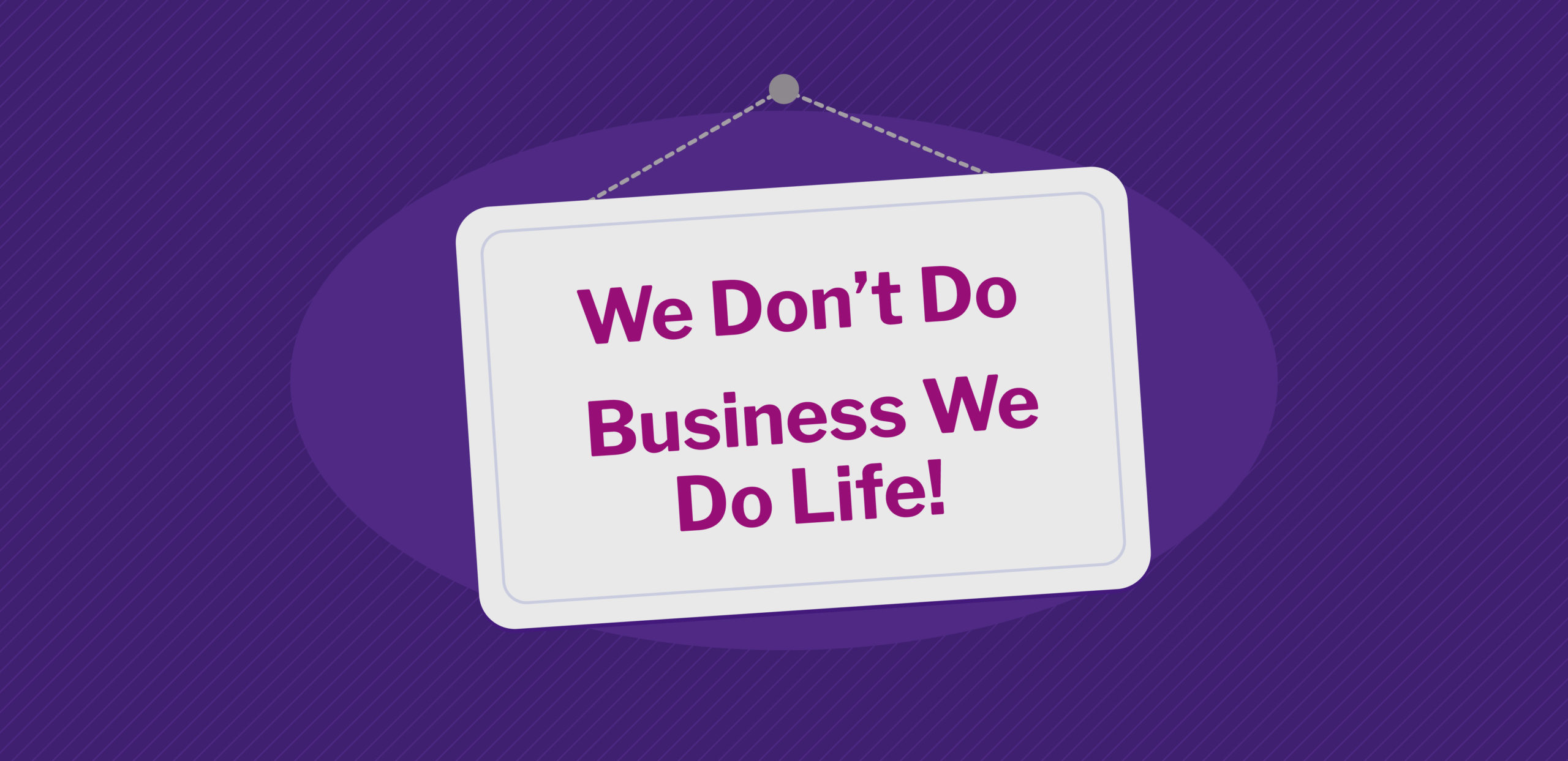“My Life is Mine”
Workforce Evolution and the Employee Experience
We’re at a tipping point in workplace history. The employee/employer power dynamic has shifted. Employees are questioning the way in which work has been conducted for 100 years; they no longer think “because that’s how it’s always been done” is a good enough reason. And if their organization isn’t changing right along with them, they’re leaving. It’s that simple.
We Don't Do Business - We Do Life!
Years ago, a sign hung in our lobby that we felt very strongly about. It read, “We Don’t Do Business – We Do Life!” As it turns out, that sign is just as, if not more, relevant today. Brian Kropp, Chief of Research for the Gartner HR practice, says it well in a recent HBR article: “Workers now expect their managers to be part of their support system to help them improve their life experience, rather than just their employee experience.”
People want leaders and organizations to acknowledge their demand to have the same level of fulfillment, growth, joy, and even love, at work as they do outside of work. People don’t want a work life and a personal life; in the end it is one life. And the evidence shows that leaders and organizations that are striving for that goal see higher levels of performance from their people.
Leaders must accept that there are both short-term and long-term implications for a “one life” mindset. If they simply say, “This too shall pass,” or stay steadfast in believing that their organization needs to go back to the way things were done pre-pandemic to be effective, they will ultimately find they’re creating mercenary workforces, experience ongoing retention issues, and not be able to attract the top-tier talent that they were once able to.

Three Employee Experience Challenges Facing Leaders (And How to Solve Them)
To help leaders find success in this new world of work, I’m highlighting three of the most pressing issues currently facing the workplace and offering actionable solutions that can make a positive impact today. At the core of all these issues is the need for leaders to create an employee “life experience” that represents what people most value today in their ever-changing expectations on the environment and culture of where they work.
“People want leaders and organizations to acknowledge their demand to have the same level of fulfillment, growth, joy, and even love, at work as they do outside of work.”

Issue 1: Routines and Practices That Waste Time
People have become increasingly less tolerant and less willing to do things they used to simply because they always have. Our people are not stupid, and they recognize when they’re being asked to do things that don’t add value. What is constantly astounding is how much time is wasted on redundant activities, checkers checking the checkers, and activities that add little or no benefit to customers or colleagues.
When we ask people how much of their time is wasted at work, they respond with numbers as high as 30% to 40% of their total time. The Anatomy of Work Index puts that number even higher – the average worker spends 60% of time on mundane duties that add little value.
And now people are seeing leaders asking them to come back to work in their offices or facilities – not because the work requires it – but because leaders believe if they can physically see those people, they can be held to higher levels of accountability.
So we’re seeing two converging issues that are giving people significant pause – doing work that adds no real value and being asked to come back to an office space that isn’t required to actually do the job they’re tasked with.
All this despite an abundance of data that says productivity increased in the last year. This unbalance is catching up with us.
This has broad organizational consequences on performance, as well as performance at the team level. It impacts customer experiences. As more and more individuals leave, the remaining folks are bound to start asking themselves if they too are unhappy. They’re not being given the opportunity to grow and develop because they’re too busy doing meaningless tasks. The energy and culture of the workplace shifts. And it most certainly increases turnover. How does this help any business? It doesn’t.
Solution: Eliminate the unnecessary.
What should leaders do? Every leader needs to ask much more often and much more rigorously, “Are we setting our people up for success? Are we creating an environment that declusterizes the useless routines and practices that add no real value?” Organizations must stop asking people to do nonessential activities in order to create capacity and freedom for our people. When they’re not bogged down in the check-the-box list of tactics or the areas that don’t truly impact the business, they’re able to create mindspace for the approaches, tasks, routines that do deliver real results.
This comes with a huge ask of your managers and your people. To be successful in an environment and culture that fosters this approach to productivity, your people must absolutely understand what the company is trying to achieve and how they – at their individual and team level – can directly affect those results. That takes time and energy to ensure that people are having the right discussions around those goals. And it needs to be fostered on an ongoing basis.
Gartner’s Redesigning Work for the Hybrid World report tells us that 68% of HR leaders agree that many managers are overwhelmed by their responsibilities in today’s hybrid work model, and only 14% of organizations have adjusted the manager role to compensate for new responsibilities. This means that leaders need to dedicate more time to ensuring that managers have the skills they need – including being empowered to embrace change.
Often, those in decision-making roles feel an allegiance to the status quo. But this mentality is a deal-breaker for today’s workers. The recent HBR article To Make Hybrid Work, Solicit Employee Input tells us, “Research has found that some managers actively disregard employees’ ideas because they identify heavily with the status quo, but it’s important that leaders encourage recurring feedback and embrace policies as adjustable to meet the organization’s needs.”
To this point, change must be not just suggested, but mandatory – and this mindset starts at the top – because the past way of working and leading no longer applies.
Issue 2: Moving from Duality to Singularity
People don’t want to live two lives. Having fun at work while supporting an overarching purpose isn’t a nice to have; it’s a must.
People are asking, “Why do joy, love, and excitement have to only apply to my personal life?” They’re telling us in their words and their actions, “There’s just one me.” They will no longer compartmentalize their work self and their personal self. They have one life – one set of expectations.
What people have found in the last year or so is that it is possible in certain organizations to eliminate the dual-life scenario. They do not have to go “back to the grind” or “work to live.” They don’t want to have one attitude at work and another at home.
People know it’s possible to be happy at work and happy at home; they don’t want to settle any longer for anything less than a fulfilling, inspiring, and engaging workplace. Make no mistake – this doesn’t mean they expect it to be fun every day or that they don’t have to work hard. Everything worth having is worth working for.
How can leaders ensure their organization supports the “one life” mindset?

Solution: Focus on purpose and people.
Purpose is truly at the core of this challenge and opportunity. At a time when competition for talent is great, organizations must have a mission and engage everyone on that journey. This is the only way to keep people excited and employed.
For example, the same HBR article reports, “Companies that lend support to workers’ entire employee life experience — offering flexibility, building deeper employer-employee connections, and creating a shared purpose — see better employee well-being and produce 21% more high performers.” This 21% is massive. If organizations can get 21% more of their people engaged and performing well, then these people can lead by example, and hopefully this energy and satisfaction will envelop even more folks in the business.
Connecting your people to the purpose of your organization – every single day – is critical. If they know what they’re getting up every day to work toward and they know that they’re delivering value to the end user, the shift in attitude and performance is astounding. People want to understand that the place they work and the people they work with share the same values as well as the same goals and objectives.
People need to like the teams they work with, and believe they’re valued and appreciated by their colleagues and leaders. When this happens, they feel like they’re “in the trenches together” working in a partnership and collaboration, which creates great things. If you have a relationship that doesn’t make you feel good, you’re not going to continue that relationship. Why should work be any different? We all have choices we can make, and picking who we work with is at the top of the list.
“People know it’s possible to be happy at work and happy at home; they don’t want to settle any longer for anything less than a fulfilling, inspiring, and engaging workplace.”
Issue 3: What Matters to You Might Not Matter to Me
Today the disconnect between how leaders think they should be leading and what people want out of work are not meshing. As leaders have been overwhelmed with keeping businesses on track, people’s needs and wants have shifted. And the two groups have yet to realign. This is a problem.
Because if leaders don’t understand their people’s needs, the business isn’t going anywhere. Leaders need to realize that people don’t care about their salary like they used to. The money isn’t the driving factor, and if a worker is disenchanted, then the paycheck doesn’t matter.
If you think your people are only motivated by money, then you are fostering a mercenary workforce, which isn’t good for productivity, and it’s definitely not good for your customers.

Solution: Foster a mindset of co-investment.
Leaders need to stop thinking, “Because we pay you, we can tell you what to do.” Our people are not indentured servants. They want leaders who are constantly thinking, “How can I continue to foster your talents? How can I challenge you to become more?”
Alignment occurs when we create an environment where people feel connected to the whole, and truly believe that leaders are supporting people in growth and happiness at work. Then the disconnect fades away and everyone is connected by the same things that matter to all of them.
Leaders and employees must be co-invested. Therefore, leaders must develop a list of shared values. This list must be the core of what the organization stands for. Leaders must walk and talk this list each and every day. And this list must embody what employees feel passionate about.
However, as we continue to see job boards flooded with openings and recruiters working tirelessly to try to fill roles, we know this is not currently happening. When employees feel like their leaders and managers care about them, when they’re having ongoing conversations about growing their talents, fostering their dreams and goals, the shifts in behaviors and productivity are astounding.
The Employee Tipping Point
There isn’t time to pilot and trial new initiatives to see what works. Change needs to happen now. Organizations cannot wait for more workers to join the Great Resignation. Leaders must become laser-focused in their desire to stay alert to their people’s perceptions and emotions, be committed to walking in their shoes, and feel driven to create a culture where co-investment underscores everything.
Just as we study our customers’ needs and wants and have teams of folks whose sole job is to be obsessed with this data, leaders must do the same with their associates. It’s a two-way relationship. When this is done well, leaders will have an accurate understanding of their people, and as a result they’ll be able to help them unleash their talents and ensure they want to remain a part of your team.
The most significant impact to the world of work is where people sit each day. If they can work at home and prefer doing it there, that is where they will do it. People aren’t simply saying yes to employers any longer. They are setting the standards. They are forcing the changes. They are demanding that employers hear them. “My life is mine.” And if organizations don’t respond, they will continue to find resignations flooding their inboxes.







